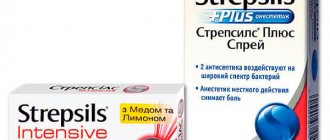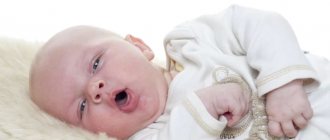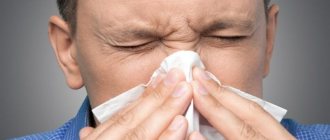Many viral and colds in children are accompanied by a cough. This is a depressing symptom that can only be calmed, thereby improving the baby’s well-being. Most children begin to cough heavily after falling asleep, when it is difficult to contact a doctor. At such moments they need help, so parents should know how to calm their child's cough at night or in the evening.
What is a cough?
Cough is a natural, protective response of the body to viral and cold diseases. It is formed as a result of contraction of the muscles of the respiratory system, which occurs under the influence of irritants on the trachea, larynx, and bronchi. All this leads to the release of air along with phlegm and harmful microorganisms from the lungs.
Coughing helps the baby cleanse the body of germs. But it can be debilitating and painful. Night cough is especially severe because As a result of the horizontal position of the child, the mucus reaches the bronchi faster, and the body immediately tries to eliminate it.
How to help a child with a wet cough?
Understanding the nature of this symptom, helping a sick baby becomes much easier. The main thing is to make the cough productive, that is, to help the body remove all the “bad” things from the bronchi with phlegm. This means that the mucus needs to be thinned and coughing up easier.
For a wet cough, you can try the following treatments:
Warming compresses
Warming is effective in soothing wet coughs. A warm compress will help relieve a sick child's condition within a few minutes. You can try mustard plasters or various folk methods like warm potato cakes - the main thing is to apply the heat specifically to the chest area.
Important! If your child’s body temperature is elevated when he coughs, he should not be given any warming procedures!
Massage
A special massage of the back and chest also helps children with coughs. It is especially indicated for very young patients who do not yet know how to cough well. After such a massage, phlegm comes out very effectively.
Home Remedies
Folk remedies, such as herbal decoctions, are also effective as an auxiliary treatment in children. Thus, infusions of mother and stepmother, licorice, marshmallow root or plantain have an excellent expectorant effect.
Types of cough
Cough is divided into:
- Dry (unproductive) . Frequent coughing that does not result in sputum expulsion. It can be painful, long-lasting, and often irritates the throat of children and leads to vomiting. A child's dry cough appears in the first stages of a viral or cold disease.
- Wet (productive) . Coughing, characterized by the release of sputum. It speaks of successful treatment and promises a speedy recovery for the baby, although it may be accompanied by a serious illness.
Attention! A doctor should treat coughing illnesses. Adults can only alleviate the baby’s condition, knowing what and how to calm the attack. And to do this, you need to find out the cause of the cough, eliminate the factor that irritates the mucous membrane of the respiratory tract.
Wet cough or dry cough: how to distinguish?
Signs of a dry cough
A dry cough (or nonproductive cough) is a frequent coughing that does not result in the removal of phlegm or secretions. This means that irritation of the epithelium of the respiratory tract does not lead to any positive result. It can be quite severe and come in fits and starts, causing severe irritation in the child’s throat to the point of vomiting.
Depending on the disease, a dry cough may sound different. Sometimes these are barking coughs, for example, during an attack of false croup, sometimes they are exhausting and annoying - with whooping cough, or superficial and frequent - with an allergic or nervous reaction of the baby.
Characteristic differences of a wet cough
A wet cough is accompanied by the discharge of sputum. It is difficult to confuse it with something, since it is accompanied by characteristic sounds, and at the end there is a clearing of the throat. Such a cough can also be a companion to a serious illness in a child, but its effectiveness indicates that the process is going in the right direction.
Dry cough in children
Dry coughing is dangerous for children because it does not lead to the release of mucus, which accumulates in the respiratory tract. A dry cough can be superficial; it occurs in children with allergies or a nervous reaction. And barking, which appears due to inflammation of the vocal cords and larynx. It is accompanied by diseases such as whooping cough, false croup or laryngitis.
A barking cough occurs unexpectedly and in the middle of the night. Children wake up from the fact that they begin to choke and cannot clear their throat. First, you need to call an ambulance, and while she is on her way to calm the baby, panic will not allow him to restore his breathing rhythm and calm down the attack. All parents need to know how to calm a child's barking cough at night , because... the consequences can be dangerous. In addition to viscous sputum, the baby's laryngeal mucosa swells. To relieve swelling, you need to give mucolytics, drink warm liquid, and breathe moist hot air with it in the bathroom. Children with false croup, laryngitis or whooping cough are always hospitalized.
Rending cough in a child
Acute tearing cough in a one-year-old child. Bronchitis.
Reputation points: 0
Acute tearing cough in a one-year-old child. Bronchitis. How to solve the problem without antibiotics?
Girl 1 year 2 weeks, 12 kg. Breastfed. Breast milk in the diet is 50%. Apply to the breast every 2-3 hours.
Last Friday my temperature rose, at night it was 39.2. They didn't shoot down. In the morning I feel weak, but it’s clear that everything is fine. On Monday, the baby will appear healthy, except for strong sniffles, which prevent him from fully sucking at the breast at night. So until Thursday: during the day the snot flows, but does not interfere with life, at night the nose is clogged, he cannot suck, he sleeps poorly.
On Thursday we go to the bathhouse (we go regularly, every week, I have been steaming the child regularly since he was six months old), steaming as usual (wet bath-sauna, with dousing with cold water). In the afternoon after the bath we go to bed, and in the evening we get up with a hoarse and very wheezing throat.
At night 39, acute cough, wheezing in the throat, heavy breathing. It's been like this for 2 days now.
We had approximately the same scenario at 5.5 months. Abstract bronchitis was diagnosed. They refused to go to the hospital. I tried to avoid antibiotics, I was treated with homeopathy for a week, it didn’t help, apparently I didn’t get it. Homeopath from the Garden Center. Then another 3 weeks of inhalations, wraps and massages did not help. The wheezing in the throat and hoarseness in the lungs persisted. At 4 weeks I gave up, antibiotics.
How to avoid antibiotics seisas. I don’t want to go to the Garden Center to see a homeopath after that failure (I was given Antimonium).
Here's the questionnaire.
I apologize in advance for the unnecessary information, it’s difficult to catch and write the main thing.
1.What does the patient look like? Red, pale. sweating, etc.
He looks normal, no paler than usual. There is sweating, especially during sleep; the area under the head is wet, even when there is no temperature. The baby's head sweats during breastfeeding.
2 Chilly or hot (not in general, but precisely at this moment, with a fever) (Is he chilly, wraps himself up during a fever, or is he hot, does he take off all his clothes?) If there is a temperature, temperature is not the most important thing, but you need to know.
When the baby has a fever, the baby is like a coal, all hot under the blanket, but the butt is cool, sleeps without a diaper, pees under itself, then I change the sheet under it. We sleep together, so I can feel how her condition is changing. The temperature is usually high only at night, closer to 3-4, and by 6-8 it subsides. I feel this when I take the breast, my mouth and tongue are very hot when the temperature rises.
During the heat, and always, he sticks his legs out over the blankets. He sleeps in a shirt, it doesn’t feel tight, so it’s not hot, but he never lets you cover him with a blanket up to your shoulder or neck, he throws off the blanket.
3.Thirst level
He drinks a lot greedily, but hangs more on his chest, doesn’t even suck, just keeps it in his mouth, maybe all night.
4. What language? Lips? - wet or dry (in the absence of thirst) -
The tongue is not dry, but not wet either, there is little moisture in the mouth, the lips are dry and hot. The tongue is hot during fever.
4. Is there diarrhea or vomiting?
- Stool does not change during fever. As always, there is every day, greenish, brown, sometimes black.-
6. Do your arms and legs feel hotter to the touch than usual, or cool despite the temperature?
At the temperature, the legs and arms are not hotter than usual, maybe just a little.
7. How the patient behaves - lethargic, adynamic, always sleeping or cackling, or excited, active, aggressive - in comparison with his usual behavior.
When the temperature rises, usually in the evening, he feels sleepy and easily falls asleep with boobs in his mouth. She wakes up when she is very tall, apparently cannot take her breasts, cries, screams in her sleep. I wake him up, carry him in my arms, calms down, takes the breast, falls asleep again. The next day he is lethargic, sits, does not move, and sulks.
8. His appetite, desires for food?
— He refuses to eat, but he eats his favorite dishes (cottage cheese with fruit puree) a little, 6-7 spoons.
9. Some special symptoms in behavior, psyche, mood that appeared only with the disease.
I was surprised that she laughed and immediately switched to whimpering, more often she came into her arms, she wouldn’t get off if she sat. But as soon as the temperature drops, he becomes interested in everything again and climbs everywhere. He gets distracted and plays, but after 5 minutes he comes to his hands again.
10. What surprises you about the patient at the moment?
He gets scared by coughing, at night he jumps to his feet from coughing, in his sleep he climbs onto the headboard of the bed to stand on his knees, and has to be woken up to calm him down and put him back to sleep.
It’s amazing how quickly an ordinary runny nose turns into a cough, that pediatricians immediately diagnose bronchitis. It was easy to sleep during the day after the bath, everything was fine, I woke up with a strong wheezing and a hoarse throat. At night, dry, tearing cough.
COUGH
1. What triggers a coughing attack?
- a back massage or tapping on the back provokes a cough. He starts coughing in his sleep, lying on his back, wakes up from coughing, jumps to his feet.
2. What makes a coughing attack easier?
It makes the vertical position easier - I pick her up and walk around the apartment with her. Sitting upright, he takes the breast and falls asleep again.
Eating, drinking (what kind), warm bed? Laughter, conversation? Warm drinks or breastfeeding also make it easier (he refuses to eat), it seems that the throat is dry and scratchy and the same cough comes through it, with drinking it becomes moisturized and becomes easier.
3. Is there any improvement/worsening from movement? Or, on the contrary, does the attack occur at rest, in a lying position? — During the day it is much easier to move, although the voice is hoarse and low, as if a tube was inserted into the throat. Like an attack, coughing is difficult to cope with only in sleep and closer to awakening. When moving he coughs bubblingly and manages the cough.
4. Does it make you feel cooler if you fan yourself with something?
- I haven’t tried it.
5.What is the nature of the cough? What does a cough sound like?
Jagged and dry, forcing its way through the upper lungs and through the throat. It tears my throat. The sound is deep, as if through a tube, as if with this.
6. Is there phlegm? Type, color, consistency, taste of sputum. – no, there are no macros.
7. Complexion when coughing? - blushes a little, but the cough is short-lived.
8. Spasms during coughing? Vomiting? - no, no cramps, no vomiting.
9. What is the posture during coughing, how is it better for the patient to cough? Is there pain in the chest, a desire to hold it with your hands?
- It is better to cough while sitting or on your hands. I’m not sure about the pain, we’re only 1 year old, he won’t tell.
10. Do you cough more often at night or during the day?
- Mostly at night.
11. How does a cough behave when moving from heat to cold and vice versa?
- We haven’t gone outside yet. Can not say.
12. What are your food desires? Is the patient asking for something unusual for him?
— She doesn’t eat much, she doesn’t refuse her favorite food (cottage cheese), she ate a little soup. Drinks a lot.
13. How does the patient’s behavior change when an attack approaches?
- As such, an attack occurs only at night, in a dream. He sleeps restlessly and wakes up coughing. It doesn’t calm down for a long time until you rock it vertically.
14. How did the patient’s mental state change during the illness?
He whines, screams quietly, just howls, as if he has no strength, his throat does not allow him to scream loudly. Usually the child is calm and good-natured, is not afraid of anyone, cries very rarely, and can take care of himself for a long time, but next to his mother.
15. Describe the symptoms that appear in the patient during coughing attacks.
Rough guttural sound, like an adult. Very dry to the ear.
After inhalation of mineral water through a nebulizer, the cough is slightly moistened and she tolerates it more easily. He practically pays no attention to him. The cough becomes so bubbling, as if your throat is full of drool.
Dear homeopaths, thank you in advance for your advice.
How to cure dry cough with folk remedies
A dry cough usually occurs with an upper respiratory tract disease. Inflammatory processes in the larynx and trachea are indicated by a cough with difficult sputum. A dry cough interferes with normal functioning, disrupts sleep, and creates psychological and physical discomfort. As a rule, it is very difficult for the body to get rid of the infectious agent without outside help. How to get rid of dry cough? Treatment can be divided into two groups: treatment with pharmaceutical drugs and treatment with traditional methods. Traditional methods have virtually no side effects and are highly effective, because they are based on natural ingredients.
Content
What is a cough? ↑
Coughing is the body’s defense reaction to infection. By coughing, the body tries to remove foreign substances - phlegm and mucus, which appears as a result of the activity of bacteria. With a dry cough, there is no sputum, and the cough itself is provoked by a constant sore throat. A cough greatly exhausts a person, but the process of removing the infection itself is ineffective.
There can be several causes of cough. The symptoms of many diseases are very similar, so to find out the diagnosis, it is best to consult a doctor. The most common causes of dry cough are:
- Smoker's bronchitis
Smoking causes serious damage to the entire respiratory system. If you smoke, quit this bad habit immediately. Pharmaceutical products that are sold in pharmacies to help with smoker's bronchitis only make coughing easier, but the problem itself remains and can have dire consequences. Passive smoking is no less dangerous than regular smoking. Try not to be in the same room with people who smoke.
Laryngitis is the second cause of dry cough in terms of the number of visits to the doctor. The inflammatory process affects the mucous membrane of the larynx. First, the patient has a sore throat, and after a while a cough begins.
With tracheitis, it is not the larynx that becomes inflamed, but the mucous membrane of the pulmonary trachea. As a rule, there is no sore throat; the patient is only tormented by a debilitating cough.
- Inhalation of chemicals
Household chemicals have a detrimental effect on the body. You can develop a dry cough through frequent cleaning using powders, gels, etc. Chemicals irritate the mucous membranes of the respiratory tract and can cause allergies.
Pleurisy is a serious disease in which, in addition to a debilitating cough, there is a tingling sensation in the side.
Pneumonia is inflammation of the lungs. It is sometimes mistaken for a regular dry cough and people do not seek medical attention for a long time.
How to cure a dry cough ↑
In order to cure a dry cough, you need to help the body eliminate bacteria. It is necessary to create the most favorable conditions and environment for the formation of mucus in the upper respiratory tract. For a dry cough, you should not use drugs whose action is aimed at suppressing the cough center. These medications include products containing codeine components. The best option is folk remedies that stimulate sputum production.
Proven compositions from traditional healers ↑
If dry porridge appears after suffering an acute respiratory disease, then ordinary baking soda can be used to suppress it. Gargling with warm water and soda will help reduce coughing attacks, since this solution thins mucus, disinfects and disinfects the respiratory tract. Dissolve a pinch of soda in a glass of water, gargle 5 times a day for 1 minute. This procedure is effective if the cause of the cough lies in the inflammatory process in the larynx. If the inflammation is localized in the upper parts of the bronchopulmonary tree or trachea, then it is better to do inhalations. For better results, you can add a decoction or essential oil of chamomile to the soda mixture. The water temperature for inhalation should not exceed 40 degrees.
To relieve a dry cough, drink more fluids. The ideal option is alkaline mineral water or herbal infusions. Drink warmed mineral water in small sips throughout the day.
In a glass of warm (but not hot!) milk, dissolve 1 teaspoon of butter, 1 teaspoon of flower honey, drink 1 glass a day 20 minutes before meals.
Lubricating the throat with olive oil will help reduce tickling in the respiratory tract and the cough reflex.
Radish is an excellent cough remedy. Its juice with honey is considered beneficial. Honey, which gives the juice viscosity, has many beneficial properties. It is necessary to repair 1 radish by making a hole like a cone. Add 2 teaspoons of honey inside, lower the root vegetable into a cup or glass so that it is fixed between the walls and does not touch the bottom. After about an hour, the radish will release juice. Take it 3 times a day, a teaspoon. You need to swallow in small sips so that the juice coats the walls of your throat.
Ginger is called a cure for a hundred diseases. It will easily help cope with dry cough. Grate the ginger root on a coarse grater, add vodka, after 5 days take 20-30 drops 3 times a day 30 minutes before meals.
Another proven remedy for dry cough is milk. Milk with cream is heated to 50 degrees. For a glass of milk you need to add 2 teaspoons of honey and 1 chicken yolk. Drink in small sips 2 times a day after meals.
Medicinal decoctions for dry cough ↑
Using herbal decoctions internally will help cure or partially alleviate dry cough. But remember that they cannot be used for bronchial asthma. Asthma and allergic diseases are at approximately the same level. Some components of herbal teas may cause allergic reactions.
- Decoction of linden leaves
For cooking you will need dried crushed linden leaves at the rate of 1 tbsp. spoon per glass of water. Pour the leaves into water, bring to a boil, let it brew for 10 minutes, strain. Take 3 sips every hour throughout the day. Small portions of the decoction have a beneficial effect on the respiratory system. Train yourself to add a few linden leaves to your regular tea. This way you can diversify the taste of tea, and, of course, get rid of a dry cough.
- Oregano leaf decoction
2 tbsp. Bring tablespoons of crushed oregano leaves to a boil in 300 ml of water, cool, strain, take half a glass a day after meals.
- Herbal collection
You can prepare decoctions from several components at once; a herbal collection from the leaves of coltsfoot, St. John's wort and linden has proven itself well. The components are mixed in equal proportions and brewed at the rate of 3 tbsp. spoons per 300-400 grams of water.
- Chest herbal tea
Breast herbal teas stimulate coughing, soften sore throat, and increase immunity. To prepare a decoction, take a mixture of added primrose, plantain, chamomile and dried rose hips. Grind the rose hips and mix with herbal mixtures. Take all herbs in a 1:1 ratio. 3 tbsp. spoons of the mixture, pour 1 liter of water, bring to a boil, reduce the flame, let simmer for another 10 minutes, strain, add 5 tbsp. spoons of sugar. Sugar can be replaced with honey, but keep in mind that honey can only be added to cooled water. Throughout, you need to drink half a liter of this decoction in equal parts.
- Decoction of thyme and fennel fruits
Take half a teaspoon each of thyme, flax seeds, fennel fruits, chop. Add 2 tbsp to a glass of cold water. spoons of herbal mixture, let it brew for 1-2 hours. After this, bring the infusion to a boil. It is better to do this over low heat in a stainless pan. Take the decoction 3 times a day, 50-70 grams.
- Infusion of pine buds
To prepare the decoction, both dry and fresh pine buds are used. Place 3 teaspoons in a saucepan, pour 1 cup of boiling water, cover with a lid, wrap it up to create a thermos effect. After half an hour, strain and pour the infusion into a glass container. Take 1 sip when you feel the urge to cough.
- Bran decoction
In some cases, a bran decoction can cure a dry cough in just a day. To prepare it you need 500 g of rye or wheat bran. Fill them with two liters of water and bring to a boil. Stir constantly. Leave the broth for 1 hour, strain through gauze. During the day you need to drink the entire decoction. Drink it warm. To maintain the temperature of the infusion, pour the bran decoction into a thermos. If desired, you can add sugar or honey to the drink.
- Bee products for dry cough
In the morning before breakfast, eat 2 teaspoons of honey. Honey lubricates the throat, which makes coughing much easier.
Dilute 1 tbsp. spoon in 1 glass of warm water. The water should be warm, not hot. Drink 4-5 sips every 2 hours.
Propolis is a unique beekeeping product. Dissolve a piece of propolis throughout the day. Along with saliva, healing components will enter your body, which will help with dry cough and sore throat.
Inhalations for the treatment of dry cough ↑
Inhalations act directly on the respiratory tract, so they are effective at any stage of the disease. For inhalation, you can use both decoctions and essential oils of plants. The most effective oils are coniferous trees: pine, fir, cedar. Drop a few drops of essential oil into water whose temperature is no more than 45-50 degrees, and breathe in the warm vapor of the oil.
Inhalations with a decoction of potatoes, plantain, lavender, and chamomile give a good effect. To prepare, take 5 tbsp. spoons of raw materials, pour 1 liter of water, bring to a boil, cool. Bend over the pan, cover your head with a towel, breathe for about 15 minutes. It is strictly forbidden to breathe over a freshly brewed decoction, as this can cause burns to the respiratory tract. This effective procedure is contraindicated for hypertension, as it can cause increased blood pressure.
When treating dry cough in medical institutions, the patient may be prescribed an inhalation procedure in which microparticles of the drug create a special cloud. With the help of inhalers-nebulizers you can cure cough in young children. By the way, children's bodies react sharply to dry air. Make sure that the air in the apartment is moderately humid.
If a dry cough does not go away for a long time, consult a physician. Don't self-medicate! Only a qualified attending physician will be able to identify the cause of the disease and prescribe the necessary treatment.
Doctors on the treatment of a “tearing” painful cough ↑
Rending cough. Need some advice. For all
The beauty came from the garden and after a couple of hours the cough began. Rending. Every 30 seconds, non-stop.
The throat does not look red, there is no tempo. Only this cough and slightly clear discharge from the nose.
She's sleeping right now and her cough is just choking her.
dry cough
Girls, please tell me what folk remedies can cure a dry cough.
24 Aug 2008 16:44
ELEN, what age is the child? My eldest son is 11 years old, but from the age of two he was constantly ill, mainly with diseases such as laryngitis - this is generally dangerous, if treated at the wrong time, the child can generally suffocate from swelling of the larynx, but the first thing is inhalation. From early childhood Since we were two, he and I have been doing such procedures, I brewed herbs, even boiled them (eucalyptus, sage, chamomile, etc. for the respiratory system), sat with my son on a chair, put this pot of herbs on the table, covered ourselves with a blanket, and in this moment I poured 1 tbsp of soda into the herbs (it rises like a cap, but you need to stir it), and they breathed this steam for 10-15 minutes. After this procedure, be sure to steam the legs in mustard and salt, it is better to do all this at night. Even if he sometimes woke up at night coughing, I brewed tea to cool down a little, added a little raspberry jam (honey is not suitable for us personally, he began to cough even more ) and gave him something to drink, he lay down again and fell asleep.
I do these procedures for my children not only when they have a cough, but even when they get sniffles or freeze if it’s outside in winter, of course, if there’s no temperature. You can’t take a steam bath at t.
If my advice helps even a little, I’ll be glad, it’s not difficult. Good health to you and your child.
Sources: https://www.1796kotok.com, https://3ladies.ru, https://www.baby.ru, https://forum.say7.info/topic7963.html
Next articles:
- In the evening, a child has a dry cough
- Dry cough in a child sinekod
- Obstructive cough in children
September 10, 2020
Comments: 1
25.01.17, 10:14
Karina
I also turn on the humidifier, a very necessary thing. And for a dry cough I give the child Prospan in syrup. It thins mucus and a dry cough goes away faster.
Causes of dry cough in children
The causes of a dry cough attack are:
- the presence of inflammatory processes in the body;
- expressing emotions by screaming;
- dust and other allergens;
- cool air in the room.
A dry cough can torment the baby for a long time, pain and sore throat may appear, and even complications may arise. If there is no sputum discharge after several days, then medications must be added to treatment. And you can calm a child’s dry cough with folk remedies.
Basic recommendations for getting rid of cough of any kind
So, how to calm your baby's cough?
Moist air and regular cleaning of the room
To make breathing easier, there should be fresh air in the house. When a child is sick, be sure to ventilate the room more often. Move the patient to another room, and in the one where his bed is located, open the window.
Don't forget about wet cleaning. It's not just that cleanliness is the key to health. Even the smallest specks of dust entering the respiratory tract can trigger new coughing attacks.
You need to humidify not only the floor, but also the air in the room itself. If possible, install a humidifier in it. If not, you can place towels soaked in plain water on the radiators.
Episodes of night cough may indicate an allergic nature. Check for possible allergens in the room where the child sleeps, change bed linen, pillows and blankets.
Lighter diet and plenty of fluids
During illness, the child should eat gentle food - light, easily digestible and not irritating to the throat. Dishes should be served warm. Hot drinks or food will only increase irritation.
Drinking plenty of fluids is one of the most important points in treating a cough! The body needs fluid to thin mucus and remove it more easily.
Inhalations and lozenges
Moisturizing inhalations are good for coughs. It is best to use a special inhaler. Ordinary mineral water “Borjomi” or “Essentuki” will do. Such inhalations soften an irritated throat and improve sputum discharge.
Do not forget about softening lozenges (before taking them, consult your doctor). A throat irritated by frequent coughing itself provokes new attacks. Try to break this vicious circle.
Folk remedies
Honey is very good for soothing the throat. In addition, it also has antiseptic properties. However, you must be sure that the child is not allergic to bee products. In any case, the norm for children under 6 years of age is no more than half a teaspoon at a time. You can stir honey in warm milk or water.
So-called distraction procedures also work well. Warm foot or hand baths cause a rush of blood to the extremities, which means a decrease in swelling in the airways.
How to calm a dry cough
To relieve a child's dry cough at home, you can:
- Alkaline drinking. It soothes non-productive cough. Children should be given warm mineral water (still) as often as possible during the day.
- An older child can be given warm milk (1 tbsp) and soda (1 tsp) to drink. To improve the taste, add a little honey if desired. But if the cough is allergic in nature, you should not use it. Honey is a strong allergen and can only make the situation worse.
- Steam inhalation will help relieve cough effectively. To do this, boil 1 liter of water and add 1 tbsp. soda Immediately place the child over the steam container and cover him with a blanket, blanket or blanket. For small children under 3 years of age, this procedure is dangerous because they may accidentally drop the hot container and get burned. Therefore, in order to stop coughing, it is better to go with them to the bathroom, turn on the hot water, wait until the room is filled with steam and sit there for a while with the baby, breathe.
- Hot raspberry tea is the best homemade preventative medicine for dry cough. It should be given at the first sign of a cold so that the baby does not get sick.
Each method of cough relief should be discussed with your doctor so as not to harm the child. Children are individual, for example, they may have intolerance or allergies.
Treatment of cough at home
Experts do not recommend self-medication, but in an emergency it may be necessary (to relieve an acute coughing attack). The following therapy methods will help with this:
- Rubbing - for this they use Doctor Mom ointment, warming balm Badger, Eucabal balm, etc. They gently rub the child’s chest (for a dry cough) or do a light massage. But these drugs are contraindicated for children under 3 years of age.
- Steaming feet in mustard - several tablespoons of mustard powder are stirred in a basin of hot water (optimal temperature 37-38 degrees), where the child should place his feet and hold for 15 minutes. After warming up, you need to put on wool socks. Repeat the procedure 3 times a day.
- Warm milk with honey - stir 1-2 tsp in a glass of warm milk. honey and give the baby a drink before bed. The procedure can be repeated 2-3 times a day.
- Thyme decoction - 1-2 tsp. dry herbs (or filter bag) pour a glass of boiling water, cool until warm and strain if necessary. Drink half a glass in small sips 2-3 times a day.
- Inhalations - for a dry cough, you can do inhalations (for example, using a nebulizer or simply breathing steam over a pan). Herbal decoctions (sage, mint, eucalyptus, etc., 3-4 tablespoons per liter of water), soda solution (2-3 tablespoons per liter of boiling water), as well as mineral water (for example, Borjomi).
If after several procedures the child’s condition does not improve, this may be a reason to consult a doctor.
How to calm a wet cough
The final stage of the disease is accompanied by a wet cough. But the recovery process may be delayed if the sputum does not drain well. To avoid this, you need to apply warm compresses to the chest area (mustard plasters, ointments) and steam your legs before going to bed. But when the baby’s body temperature is elevated, such procedures are prohibited.
It is good to calm a child’s wet cough at home with inhalations with essential oils. They calm the child, normalize his sleep, and help get rid of phlegm. If they are not available, then boiled potatoes will help you. Its moist vapors promote better removal of mucus from the bronchi.
How to relieve a child’s night cough: advice from Dr. Komarovsky
Until the age of three, it is difficult for a baby to cough up mucus, so attacks worsen at night. Pediatrician Komarovsky tells how to help a child:
- Treatment should only be prescribed by a doctor after diagnostic measures. The doctor accurately determines the type of spasm and prescribes the appropriate medications.
- Temperature is only needed if it is above 38.5 degrees. You cannot give antipyretic medications if the thermometer is at 37-38 degrees.
- Attacks of night cough in a child intensify if the room is excessively hot or the air humidity is disturbed. Ventilation should be carried out twice a day.
- You cannot prescribe medications yourself at home. Using sedatives at hand can harm the baby, depending on the type of spasm.
- Drink plenty of fruit drinks, compotes and tea with lemon, raspberries or honey.
Any experienced pediatrician will tell you how to relieve a child’s cough at night. This symptom cannot be ignored, as it may indicate pathologies and serious health problems.
Author of the article:
Physician Therapist, Pulmonologist, Expert in Pharmacology
Attention! We are not a “clinic” and have no interest in providing medical services to readers. We also remind you that it is impossible to prescribe safe treatment “on the Internet” without an in-person appointment! All recommendations are indicative only. Contact specialists.
Source
It is common for a child to cough during a cold. It appears at the first symptoms of the disease and passes along with the disease. However, sometimes the cough lasts a long time. Dry cough is especially dangerous. His attacks most often occur during sleep. Why is this happening? How to relieve a severe cough and soothe your throat at night?
Night cough is a symptom that is necessarily preceded by some reason; The parents’ task is to identify it and take the necessary measures
Cough medicines
Cough medicines for children can be divided into three groups:
- Expectorants (Mukaltin, Ambroxol, Bromhexine, ACC, etc.).
- Calming.
- Thinning agents (Lazolvan, Ambrobene, etc.).
Depending on the disease and type of cough, different drugs are prescribed. For example, obstructive bronchitis is accompanied by viscous sputum, which is difficult to clear. The child should be given thinning medications first, then expectorants. Massage the back and chest, thereby helping the phlegm to drain better. With tracheitis, in the first days the baby experiences a dry cough; he needs to be given mucolytic drugs, and after a few days, expectorants. Viral pharyngitis is accompanied by a frequent, dry cough. It is necessary to do inhalations, and give sedatives at night to improve sleep and calm the baby.
Attention! Only a pediatrician can prescribe treatment with certain drugs and indicate their dosage, taking into account the disease, age, weight and other data of the child.
Types and degrees of nonproductive cough
A cough can bother a child constantly during the day or only at night, cause painful sensations or proceed without them, vary in sound (we recommend reading: a child has a wheezing cough - what do we do?).
Depending on the manifestations, there are different types of dry cough. Types of nonproductive cough include:
- Barking. During it, the child experiences shortness of breath, breathing becomes difficult, wheezing appears, and the voice changes or is lost.
- Pulmonary or paroxysmal. The cough is prolonged, during which the respiratory muscles become very tense, chest pain occurs, and tears flow.
- Surface. The attacks do not last long, but the voice may disappear, the sound of coughing tremors is muffled.
Typically, such a cough becomes productive after a few days, but sometimes it drags on for a long time. There are different degrees of nonproductive cough depending on the time period. Acute lasts no more than 3 weeks. When the symptom of the disease drags on for 3 months, they speak of a lingering cough. A cough that lasts more than 3 months becomes chronic.











